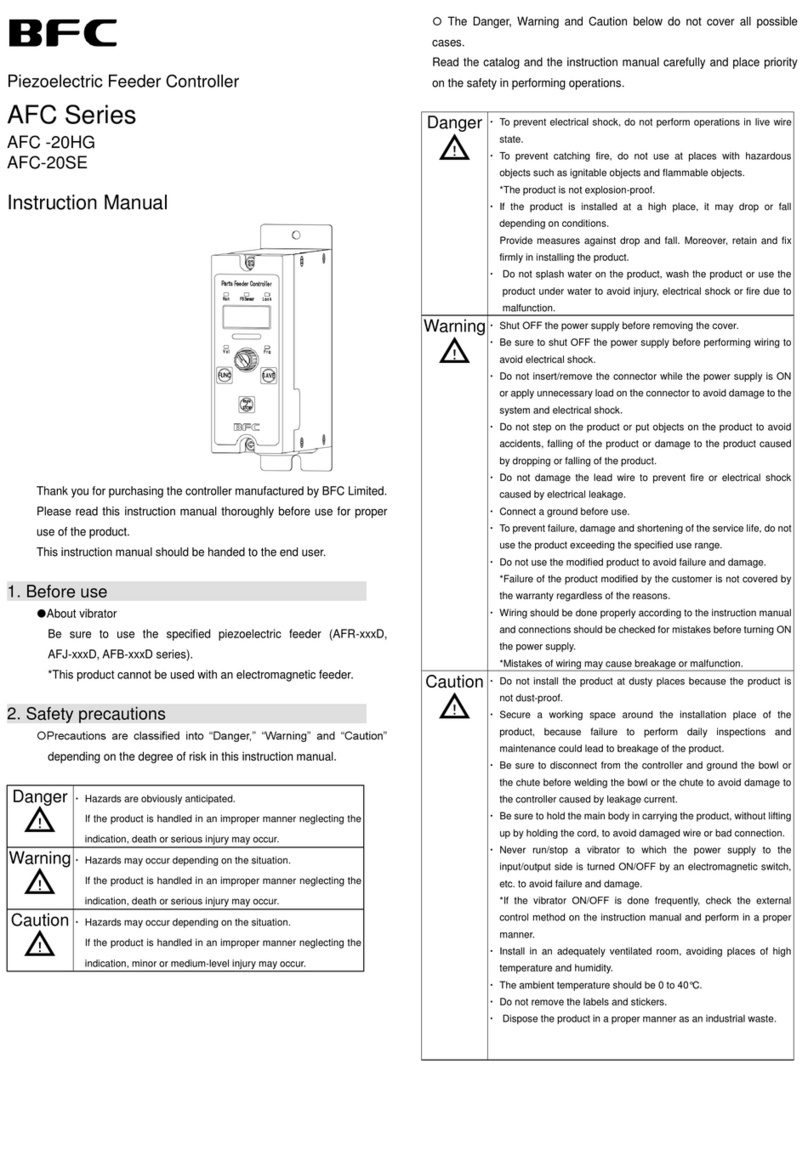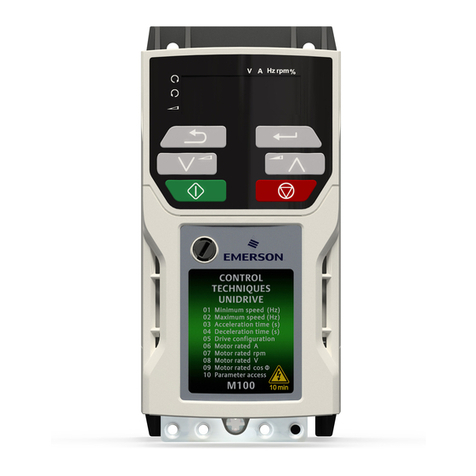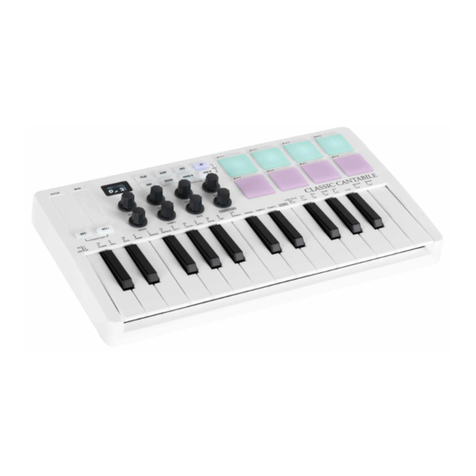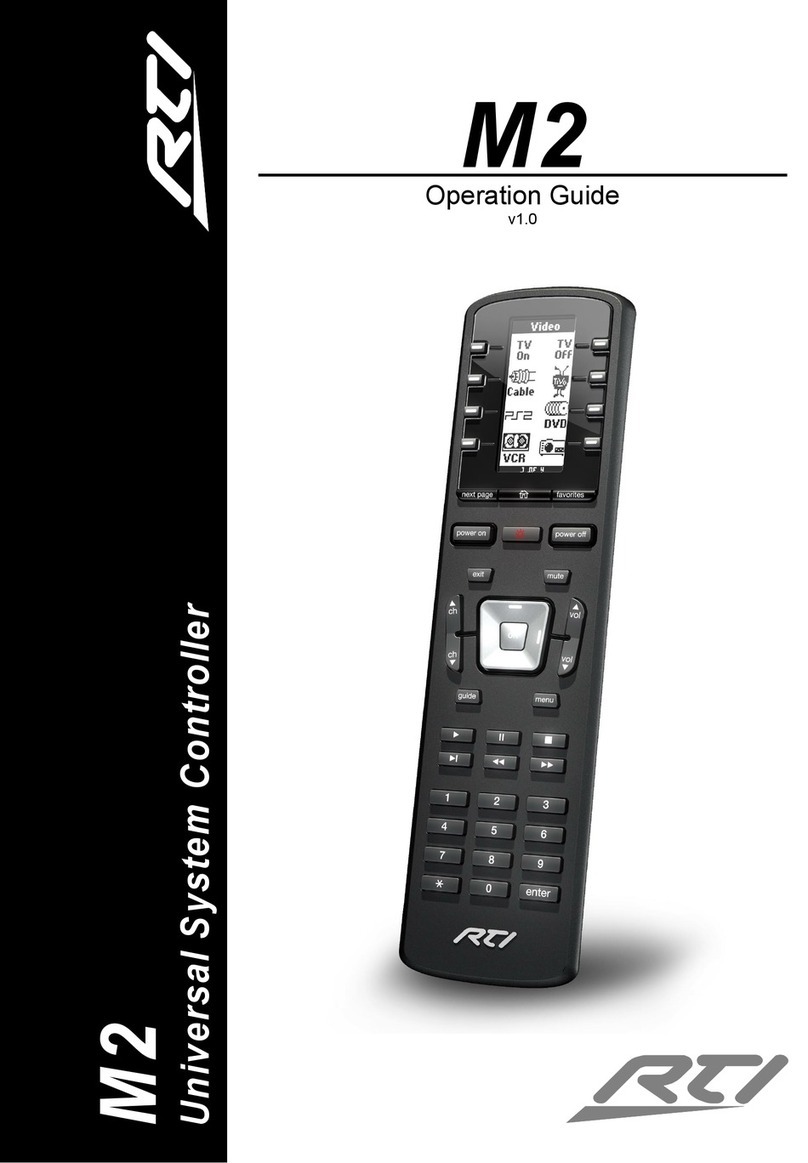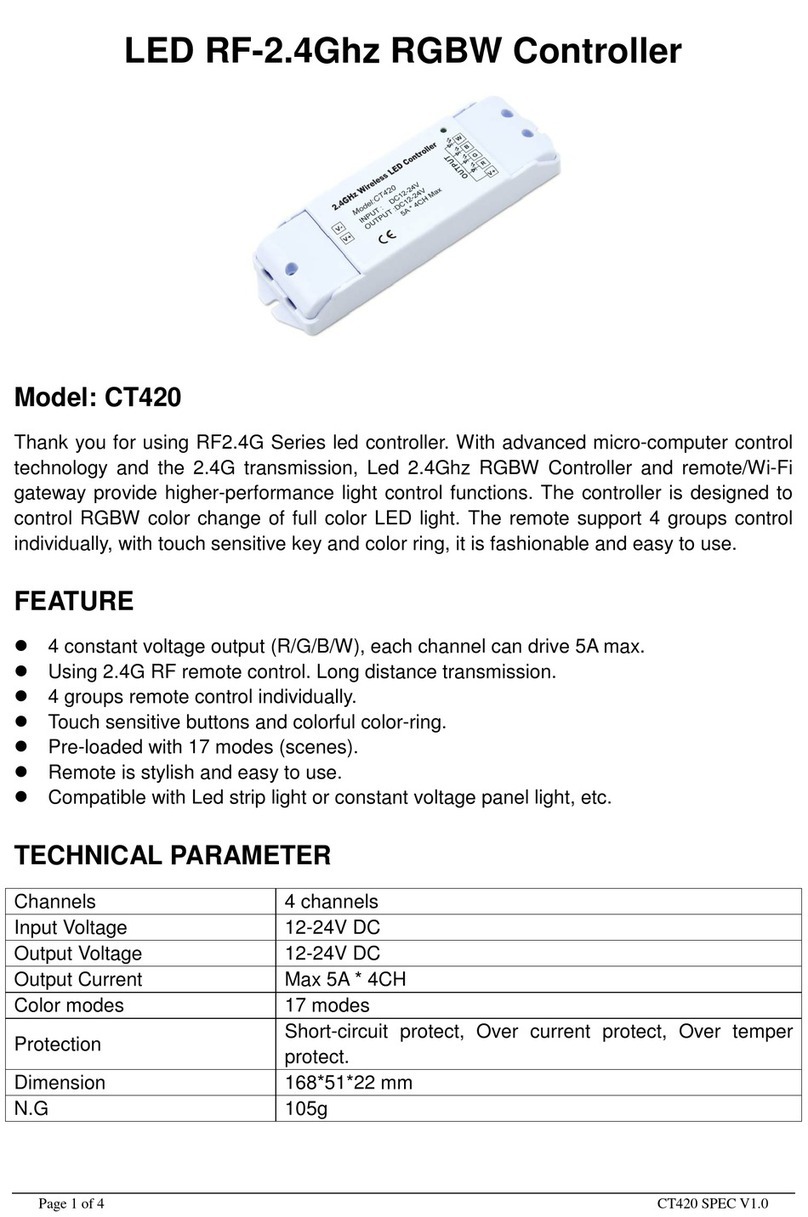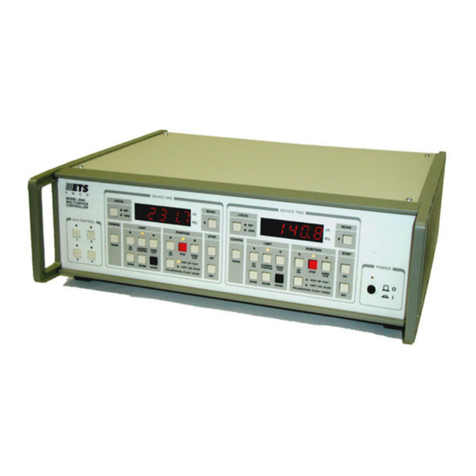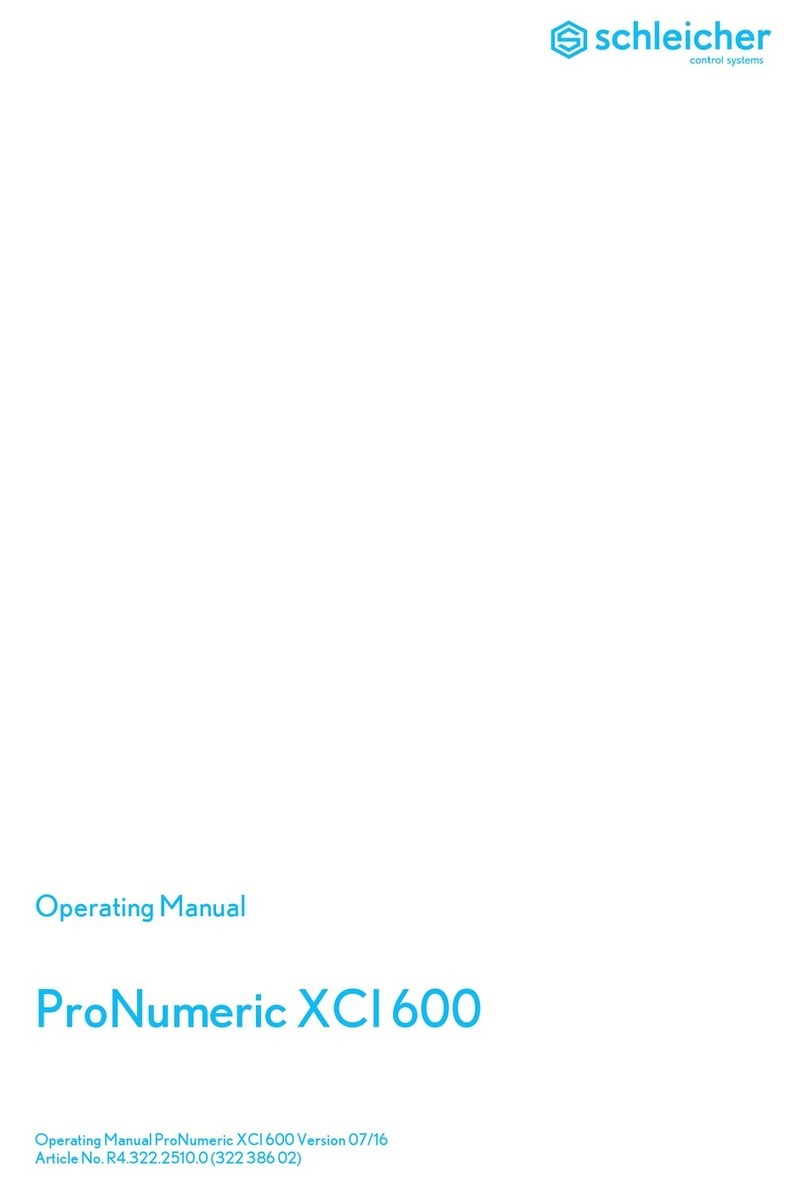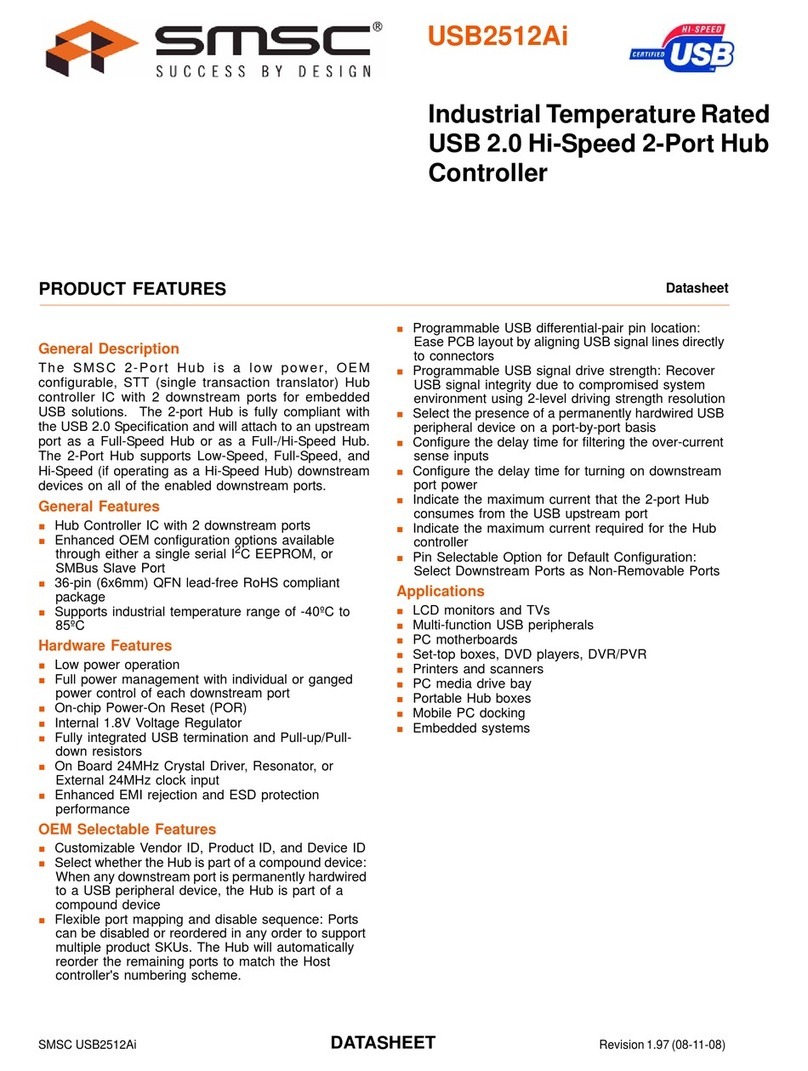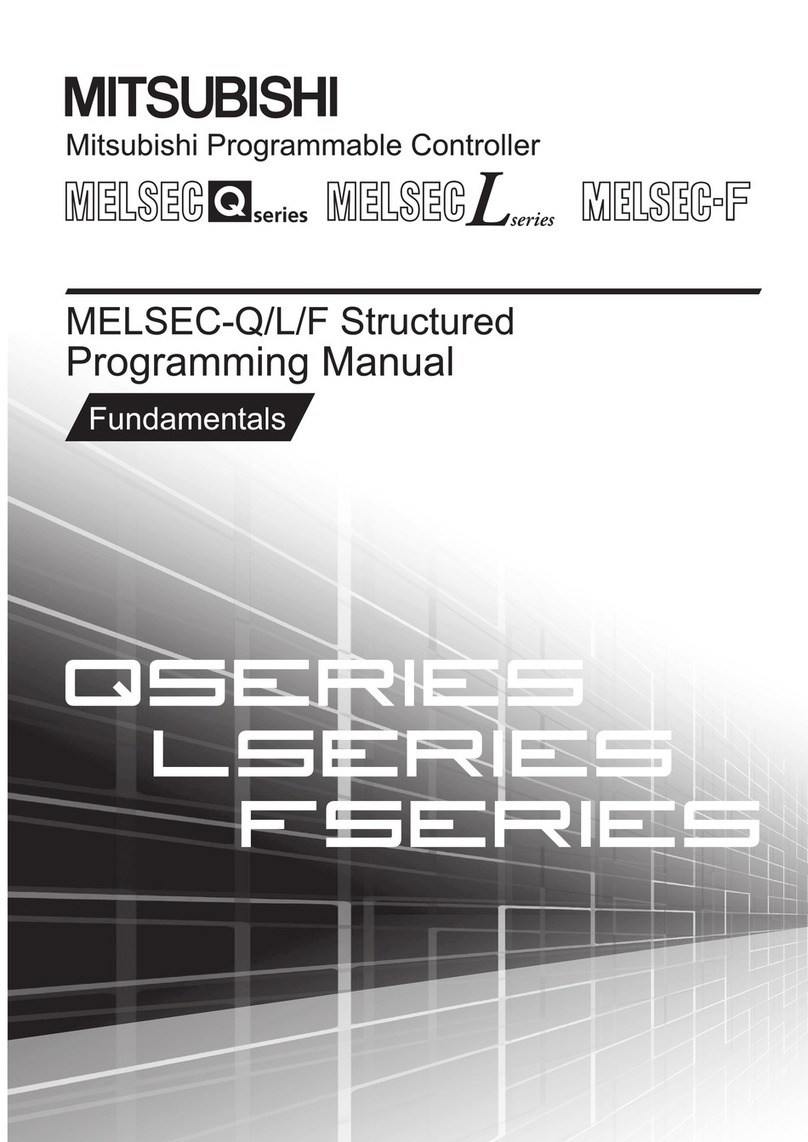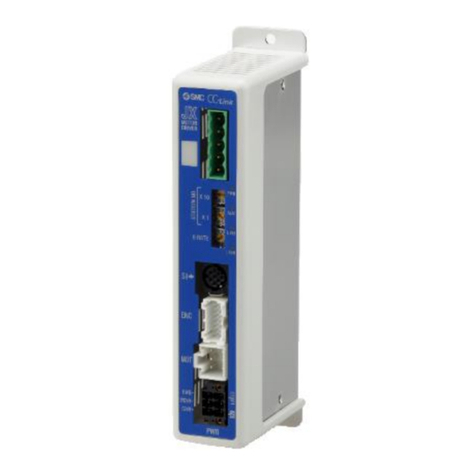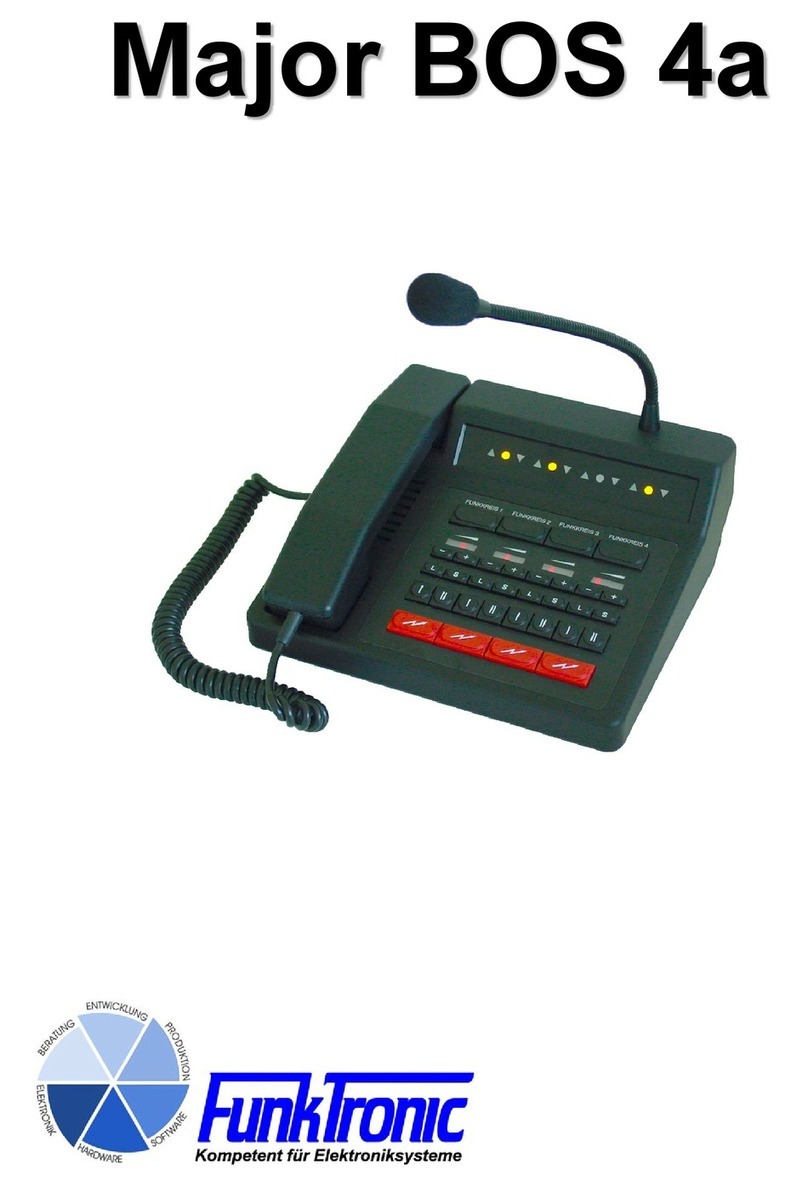BFC VMC Series User manual

HTE302172 0/38
HTE402559
Instruction Manual
Model
This instruction manual applies to
VMC-controller which installs the program
version 6 and later.
Please check the program version of your
VMC-controller on the version information.
CONTROLLER
VMC
VMC
VMC-101SF
VMC-103SF
VMC-105SF
Before use VMC-controller, please read this “Instruction Manual” including “Safety
Instructions” thoroughly to use it in the right way. Please keep it on file for further reference.

5
HTE402559 1/47
Thank you for buying your VMC-Series controller. Before use VMC-controller,
please read this “Instruction Manual”, including “Safety Instructions”, thoroughly to use
VMC-controller safely and in the right way. Please keep it on file for further reference and/or
maintenance. Please hand this manual to the operator of the partsfeeder.
Introduction…………………………………………………………………… 1
Safety Instructions ………………………………………………………… 2
Wiring Connections ………………………………………………………… 5
How to operate the Control Panel ……………………………………… 7
・ Name and Function of the Buttons, Lamps and Dials on the Control Panel …… 7
・ How to Run and Stop the Partsfeeder …… 8
・ Alarm by blinking “RUN” lamp …… 8
・ Basic Setting up Procedure …… 9
・ How to adjust the Function Set Value …… 11
Initial Setting ……………………………………………………………… 13
・ Preparation for operation …… 13
・ How to adjust the Drive Frequency Output Range …… 14
・ How to adjust the Stroke on the Auto-tuning Mode …… 16
・ How to set the Stroke on the Constant Voltage Mode …… 18
・ How to set the Stroke on the Constant Stroke Mode …… 20
・ Scaling of the stroke …… 22
Additional Function…………………………………………………………………24
・Setting up for Keylock function …… 24
・Setting of On Delay and Off Delay Time …… 24
・Setting of Soft Start Ramp-up Time …… 24
・Connection of Overflow and Stroke sensors …… 25
How to use External Signal Terminals ………………………………………… 29
・External Operation Signal Terminals “P1” and “P2” …… 29
・Operation Synchronous Signal Terminals “Q1” and “Q2”.and “AUX .OUT”…… 30
・Speed Change /Control by 4-20mA Current
/Two-Rate-of-Feed control by External Rheostats …… 31
Conformity with CE Marking ………………………………………………… 37
Trouble shooting …………………………………………………………………… 40
Function Table ……………………………………………………………………… 41
How to Initialize the Settings ………………………………………………… 42
Outline Dimensions…………………………………………………………………… 43
Accessory List ……………………………………………………………………… 44
Specifications ……………………………………………………………………… 45
Guarantee …………………………………………………………………………… 46
Introduction
Sales offices …………………………………………………………………………… 47
Contents

5
HTE402559 2/47
Before use VMC-controller, please read this “Safety Instructions” carefully to use
VMC-controller in the right way.
Use of this VMC-controller involves electrical current. There is potential hazard of
electric shock to the operator. Failure to follow these instructions may result serious
personal injury or property damage.
Safety Instructions are classified into “Danger”, “Warning”, “Caution” and “Request”.
This label shows an immediate danger.
Misuse of VMC-controller
and/or risky action of any person should
cause the person serious and/or fatal injury and/or severe damage
to your property.
This label shows an indirect danger.
Misuse of the partsfeed
er and/or risky action of any person should
cause the person injury and/or damage to your property.
This label shows an indirect danger.
Misuse of VMC-controller
and/or risky action of any person might
cause the person injury and/or damage to your property.
This label shows the manufacturer’s strong recommendation to use
the partsfeeder properly.
Misuse of VMC-controller
and/or risky action of any person may
not cause the person injury and/or damage of your property.
■Please keep this “Instruction Manual” on file for further reference giving easy access
to the operator.
■The partsfeeder that is sold or rented to the other must keep this “Instruction Manual”
on it highly visible.
They must use the partsfeeder in the right way.
■Not all danger should be covered by the “Instruction Manual”. Please read the Instruction
Manual and act on the principle of Safety First.
Safety Instructions
- Please read this article thoroughly without fail -
Danger
Warning
Caution
Request

5
HTE402559 3/47
Don’t apply VMC-controller to a piezo-electric type partsfeeder.
Don’t use VMC-controller where inflammable material exists. It has not an
explosion-proof structure.
You should fix the controller firmly on the rigid structure. Otherwise the operator
might be injured by falling down and/or abnormal operation of it.
Don’t sprinkle VMC-controller with water and/or submerge it in water, or cause the
operator injury and/or get an electric shock.
Before performing any maintenance work, such as opening cover, wiring, replacing fuse
and etc., the electrical supply must be disconnected at the safety disconnect switch.
The electrical circuit inside involves high voltage and the operator should get an
electric shock.
The electrical power supply to VMC-controller must be made through a customer-supplied
safety disconnect switch mounted next to VMC-controller.
Operate VMC-controller within the specified range in the contracted specifications,
or it causes it malfunction, damage and/or shorter life time.
Don’t get on and/or put a thing on the controller, or it results injury by fall, and/or
damage and/or malfunction of it.
Don’t bruise cords and/or leads. Bending by force, pulling, winding and/or clamping
them cause fire and/or getting an electric shock by leakage and/or mal-conduction,
and/or abnormal operation.
Wire VMC-controller correctly consulting the “Instruction Manual”. Faulty wiring
causes damage and/or abnormal operation of it.
Before supply VMC-controller electrical power, check the wiring.
VMC-controller must be grounded properly without fail. Don’t operate it without
grounding.
Warning
Danger
Safety Instructions
-Continued-

5
HTE402559 4/47
Please reserve maintenance space around VMC-controller and partsfeeder for daily check
and maintenance.
Don’t install VMC-controller dusty area. It has not dust tight structure.
Please lift VMC-controller with its body and/or mounting base. Don’t lift it with a
cable.
The output frequency range must match that of the partsfeeder or linear feeder drive
unit. Mismatch causes burnout of the coil of the drive.
Don’t supply VMC-controller with electric power through a PWM type inverter, or it
must break VMC-controller.
Don’t run and stop VMC-controller frequently. To run and stop it every few minutes
and power supply through an electromagnetic contactor mounted on the power supply make
inner electronic parts deteriorate severely. External operation signal enables it to
run and stop frequently.
Don’t provide any switch gear on the output line between VMC-controller and the drive
unit to run and stop the drive, or VMC-controller must be break.
Don’t arc weld on the bowl, chute and trough while VMC-controller and the drive unit
are wired, or earth leakage through VMC-controller must break it.
When VMC-controller might be used in circumstance and/or conditions that are out of
the supposition of this “Instruction Manual”, and/or use of it might threaten people’s
life and property in danger, consider people’s safety and act on the principle of Safety
First by the margin of the rating and performance.
When VMC-controller might be out of order or become useless, scrap it as an industrial
waste subject to local regulation.
VMC-controller should be installed on a rigid frame in such location as vibration-free,
no heat transfer, dry and no condensation, and not frozen.
Before connect or disconnect a connector, the electrical power supply must be
disconnected at the safety disconnect switch.
Don’t force a connector, or it causes getting an electric shock by leakage and/or
mal-conduction, damage and/or abnormal operation.
Caution
Request

5
HTE402559 5/47
Wire the controller and a partsfeeder or a linear feeder.
Note: See page 25 to 28 to use the Stroke sensor and Overflow sensor.
Wiring Connections
Control Panel
Case
Power Switch
Plug and Socket for Overflow Sensor
Stroke Sensor
Partsfeeder
Stroke Sensor
Linear Feeder
Plug and Socket for Stroke Sensor
Overflow Sensor
Input power is AC200 ~230V(200V
system), or 100~120V(100V system).
Output voltage is determined
automatically 190V at 200V system
and 95V at 100V system.

5
HTE402559 6/47
① Remove the control panel
② Connect power supply cable and the output cable for load. Connect the stroke sensor.
Wire each cable or lead on the terminals through rubber bushings respectively.
Power supply cable to terminals “IN1”, “IN2” and “E”
Output cable to terminals “OUT1”, “OUT2” and “E”
③ Close the control panel
The control panel must be closed and secured
while VMC-controller is in operation. Or else
the operator should get an electric shock.
Danger:
Before remove the control panel,
disconnect and lock out the power supply at
the safety disconnect switch.
Connect the ground line to terminal “E”
without fail
Warning
Danger:
Note: If any noise from the controller disturbs any other device, the controller
should provide suitable noise suppression parts on it at your own expense.
Please consult “Conformity with CE Marking” on page 37 for selection and
installation of the parts.
Ground Line
Stroke Sensor
Operation Output Signal Terminals
Output Terminals
External Operation Signal Terminals
See page 30
See page 29
Synchronous power
output terminals
See page 30
Power supply Terminals

5
HTE402559 7/47
“DISPLAY”
Data such as output voltage by
percentage representing the stroke,
drive frequency, all settings and
error codes is shown on the display.
“SELECTION” Lamps
The lamp shows what kind of data is
appearing in the “DISPLAY”.
Stroke: Output voltage by percentage
Frequency: Output frequency
Soft Start: Rump-up time of soft start
On Delay: On delay time
Off Delay: Off delay time
Function: Name of Function
“AUTOFREQ” Button
This button selects the mode to
enable or disable auto-tuning by
pushing more than three seconds.
RUN/STOP” Button
Run and stop the partsfeeder manually.
“AUTO FREQ” Lamp
The lamp is turned on the
auto-tuning mode and flickers at
auto-tuning.
“RUN” Lamp
The lamp is turned on while the
partsfeeder is running.
“ALARM” Lamp
The lamp is turned on at two occasions:
a. On the “Constant Stroke” and “Auto-tuning” modes the
output voltage of VMC-controller has saturated and it can
not chase the setting point of the stroke.
b. Any error has issued a warning.
“SAVE” Button
Push to store the data having
been set.
: Turning on
: Turning off
How to operate the Control Pane
l
Name and Function of the Buttons, Lamps and Dials on the Control Panel
: Blinking
“SELECTION DIAL”
The dial selects what is indicated
in the Display.
“SET” Button
The button changes the mode from
“Indication” to “Adjust”. On the
“Adjust” mode of Stroke and Frequency,
it changes a digit that is adjusted.
“SETTING ENCODER”
The encoder alters a numeral in the
blinking digit on the display.

5
HTE402559 8/47
1. Turn the power switch on.
Then directly the controller is running.
Note: If the function code “rS” for Run/Stop by the panel is set
to “0”the controller is operated by “RUN/STOP” button.
When “RUN” lamp blinks the external operation signal on the terminal “P1” and “P2” or Overflow
sensor is set for stop even if “Run/Stop by Panel” is set for running.
RUN/STOP External operation
signal “P1” and “P2”
Overflow sensor “RUN” lamp Operation
Button
Setting for running
Set for running Turning on
Running
Set for stopping Blinking
Stopping
Setting for stopping
Unrelated Turning off
How to Run and Stop the Partsfeeder
a. Estimated cause: The output voltage has been set for “0”.
Remedy: Set the output voltage.
b. Estimated cause: The output drive frequency of VMC-controller is off the resonance
frequency of the partsfeeder.
Remedy: Adjust it near to the resonance frequency up to get enough stroke.
c. Estimated cause: VMC-controller stops by “Error”.
Remedy: Resolve the error indicated by “ERROR CODE”. See page 42.
If RUN lamp is not turned on or the partsfeeder does not run even if the RUN lamp is
turned on please check the following items.
When the Run lamp is blinking see the next articles.
2. “RUN/STOP” button, when it is pushed, runs and stops the partsfeeder in turn.
Turning on
Turning off
Push
Stopping Running
Push
Alarm by blinking
“
RUN
”
lamp

5
HTE402559 9/47
Basic setting up procedure is described here illustrating setting up of the Stroke. The
same procedure is applied for setting up of Frequency, Soft Start Ramp-up time, On-delay
and Off-delay time.
1. Select “Stroke” with the Selection Dial turning on “Stroke” lamp.
Dialing the selection dial turns on selected lamp
in the Selection Lamp and the set value of the selected
function appears on the display.
Note: “Stroke” represents percentage of the output voltage
or amplitude per the maximum.
Note: The first letter “U” of the data appeared on the display
shows “setting by output voltage” and “A” shows
“setting by amplitude”.
Basic Setting up Procedure
Setting Encoder
: Disable
-Continued-
How to operate the
Control Pane
l
Selection Dial
Dial
Turning on “Stroke” data appears.
2. Push “Set” button to change the mode from “Indication”
To “Adjust”.
It enables alteration of the data appeared on the display
and the lowest digit blinks for alteration.
Setting Encoder: Enable
Blinking
Push Button
Blinking
“Stroke” data appears.

5
HTE402559 10/47
3. Dial the setting encoder up to appear a desirable setting value on the display.
The digit blinking is changeable with the dial.
Note: On setting “Stroke” and “Frequency” push
the Setting button to shift the digit blinking.
The“Setting of Stroke”must be set within the maximum stroke of the drive unit.
Setting Encoder
: Enable
Digit altered
Dial
Push button
4. Push “Save” button to store the data having been set.
After stored the data the selection lamp stops blinking and is turned on continuously.
The alteration of the setting becomes effective by the procedure 3.
However without “Save” action, turning the power switch off or dialing the setting dial to set
another data cancels the procedure 3. and the data stored is not renewed.
Setting Encoder
Dial
Push button
Select another function
Storing
New data is stored.
New data is not stored
Dial the Selection Dial
Push button
Note: Function code “SP-0” means Speed Change “No. 0”.
As for Speed Change see the article “External Operation Signal”.

5
HTE402559 11/47
3. Push “Set” button to change the mode from
“Indication” to “Adjust”.
It enables alteration of the data appeared on the display
and the lowest digit blinks for alteration.
Note: On the Error Code and Version Information,
“Adjust” mode can not be selected.
Blinking
Alteration enable
Push button
1. Dial the selection dial and select the function turning on “Function” lamp.
Selection Dial
Dial
Turning on
-Continued-
How to operate the Control Panel
Function data appears.
2. Dial setting encoder and select the function code altered.
Note: See page 41 for Function Codes and Functions.
Setting Encoder
Dial
How to adjust the Function Set Valu
e

5
HTE402559 12/47
5. Push “Save” button to store the data having been set.
After stored the data the selection lamp stops blinking and is turned on continuously.
The alteration of the setting becomes effective by the procedure 4.
However without “Save” action, turning the power switch off or dialing the setting dial to set
another data cancels the procedure 4. and the data stored is not renewed.
Note: Function code “SP-0” means Speed Change “No. 0”. As for “Speed
Change” see the article “External Operation Signal”.
4. Dial the setting encoder up to appear a desirable setting value on the display.
The digit blinking is changeable by the dial.
The digit blinking is alterable with the encoder.
Please set a proper value on it.
Setting Encoder
Dial
New data is not stored
Setting Encoder
Dial
Push button
Push button
Select another function
Storing
New data is stored
Dial the Selection Dial

5
HTE402559 13/47
Low frequency
←→
High frequency
Low frequency←→ High frequency
The preparation for operation is described here. Please follow each setting and see the
detail on the page in the hollow arrow .
・ Setting of Soft start ramp-up time
・ Setting of On delay and Off delay time for Overflow
control
・ Speed change with an external signal and etc.
Select the drive frequency range according to your
partsfeeder and linear feeder.
・45 to 90Hz (Half-wave Drive Unit)
・90 to 180Hz(Full-wave Drive Unit)
・180 to 360Hz(High-frequency Drive Unit)
・65 to 120Hz(Moderate-Frequency Drive Unit)
5)Everyday operation
4)Additional Function
1)Initial Setting
Set the drive frequency
output range according to
your partsfeeder and
linear feeder.
2)Setting of Stroke
Set the stroke of the partsfeeder
and linear feeder so smooth that
work pieces are discharging on
the track.
See page 14
See page 24
☆Operation mode
It is depend on using a stroke sensor or not.
Initial Setting
Preparation for operation
☆ Output Frequency Range
Auto-tuning mode “AUTO FREQ”:
Using a stroke sensor
The drive frequency chases the
resonant frequency of the
drive unit automatically.
The stroke is set manually.
Constant stroke control at the
set point
Constant Stroke mode
Using a stroke sensor
The drive frequency and stroke
are set manually.
Constant stroke control at the
set point
Constant Output Voltage mode
Using no stroke sensor
The drive frequency and stroke
are set manually
Constant output voltage
control
Stroke→
Automatic
Stay on the
resonant
frequency
Auto-tuning control image
Constant Stroke & Voltage
Stroke→
See page 20
See page 16
See page 18
3)Setting the maximum
stroke and Scaling of it.
Any trouble arises during the adjustment please initialize the
setting and restart the adjustment from the beginning. See page 42

5
HTE402559 14/47
3. Push “Set” button to change the mode from
“Indication” to “Adjust”.
Blinkin
Alteration enable
Push button
2. Dial the setting encoder up to appear code “F”,
Output Frequency Range, on the display.
How to adjust the Drive Frequency Output Range
Setting Encoder
Dial
1. Dial the selection dial and select the “Function” turning “Function” lamp on.
Function data appears.
Selection Dial
Dial
Turning on

5
HTE402559 15/47
4. Dial the setting encoder and select the drive frequency for the
partsfeeder/linear feeder controlled. The value of the function code shows
the upper limit of the output drive frequency.
5. Push “Save” button to store the data having been set
Output Frequency Range
Type of Drive Unit
F 90 45 to 90Hz Half-wave Drive Unit MB-xxxDHx
F180 90 to 180Hz Full-wave Drive Unit MB-xxxDx
F360 180 to 360Hz ―――――――
F120 65 to 120Hz ―――――――
Setting Encoder
Dial
Push “Save” button New data is stored
Storing

5
HTE402559 16/47
After finished the setting of “Frequency Range”, please set the stroke
of the partsfeeder or linear feeder.
Put some work pieces in the bowl or chute and set the stroke so that they are
discharged smoothly on the track.
Please make sure:
a. Stroke sensor is connected.
b. “Auto Freq”, indicating auto-tuning mode, lamp is turned on.
How to adjust the Stroke on the auto
-
tuning m
ode
1.
Dial the selection dial and select “Frequency” turning “Frequency” lamp on.
The maximum output frequency selected in the initial
setting appears on the display.
Check the former selection is correct or not.
Frequency Range Value
45~90Hz
90~180Hz
180~360Hz
65~120Hz
Initial Setting
-Continued-
Selection Dial
Turning on
Dial
2. Push “RUN/STOP” button.
Then the partsfeeder is running and the output drive frequency chases the resonant frequency of the
drive unit. The drive frequency becomes close to the resonant frequency the auto-tuning is completed.
“Auto Freq” lamp is blinking during the tuning and turning on after it is completed.
Push
Auto Freq: Blinking
Auto Freq
Auto Freq: Turning on
Auto Freq
How to adjust the Stroke on the auto
-
tuning mode

5
HTE402559 17/47
5. Dial setting encoder and set the stroke so that work pieces are discharged smoothly on the track.
Push “Set” button to shift the blinking digit from decimals to units.
The “Setting of the stroke” must be set within the maximum of the drive unit.
3. Dial “Selection Dial” and select “Stroke” turning
“Stroke” lamp on.
Selection Dial
Stroke data appears
Turning on
Dial
4. Push “Set” button to change the mode from
“Indication” to “Adjustment”.
Blinking
Push button
Setting Encoder
Dial
Blinking digit for alteration
Push button
Note: When the set value is lower than 10.0 alter the sensor feed back gain “Fb” to “Fine” or “1”.
It spreads adjustable range of the stroke six times and it makes setting easy and precise.
6. Push “Save” button to store the data having been set.
Push “SAVE” button Storing New data is stored

5
HTE402559 18/47
After setting the “Frequency Range”, set the stroke following the procedure below.
Put some work pieces in the bowl or chute and set the stroke so that they are discharged
smoothly on the track.
Without the stroke sensor or pulling the plug connector of the stroke sensor off
VMC-controller, the running mode is “Constant Voltage” mode.
1. Dial “Selection Dial” and select
“Stroke” turning “Stroke” lamp on.
Stroke data appears
Selection Dial
Turning on
Dial
2. Push “Set” button and change the mode
“Indication” to “Adjustment”.
Blinking Push button
3. Dial “Setting Encoder” and set the value around 70 to 80 percent.
Push “SET” button to shift the blinking digit from decimals to units.
Push button
Blinking
Setting Encoder
Dial
Initial Setting -Continued-
How to set the stroke on the Constant Voltage Mode
4. Push “Save” button to store the data having been set.
Push button Storing New data is stored

5
HTE402559 19/47
7. Push “Set” button to shift the mode from
“Indication” to “Adjust”.
Blinkin
Push “SET”
button
8. Dial the Setting Encoder in the counterclockwise to reduce
the drive frequency so that the work pieces are discharged smoothly.
Push “Set” button two times to shift the blinking digit
from decimals to units.
Setting Encoder
Dial
9. When the work pieces are discharged smoothly, push the “Save” button
to store the data having been set.
Push “Save” button
Storing New data is stored
6. Push “Run/Stop” button and run the partsfeeder or linear feeder.
This example shows the partsfeeder is running at the output
voltage 75 % and drive frequency 90 Hz.
Note: When RUN lamp is blinking
see “Alarm by blinking RUN lamp” on the page 8.
5. Dial “Selection Dial” and select “Frequency”.
Selection Dial
Turning on
Dial
Push Run/Stop
Turning RUN lamp on.
This manual suits for next models
3
Table of contents
Other BFC Controllers manuals
Popular Controllers manuals by other brands

Mitsubishi Electric
Mitsubishi Electric MELSEC iQ-F FX5-4LC Hardware manual
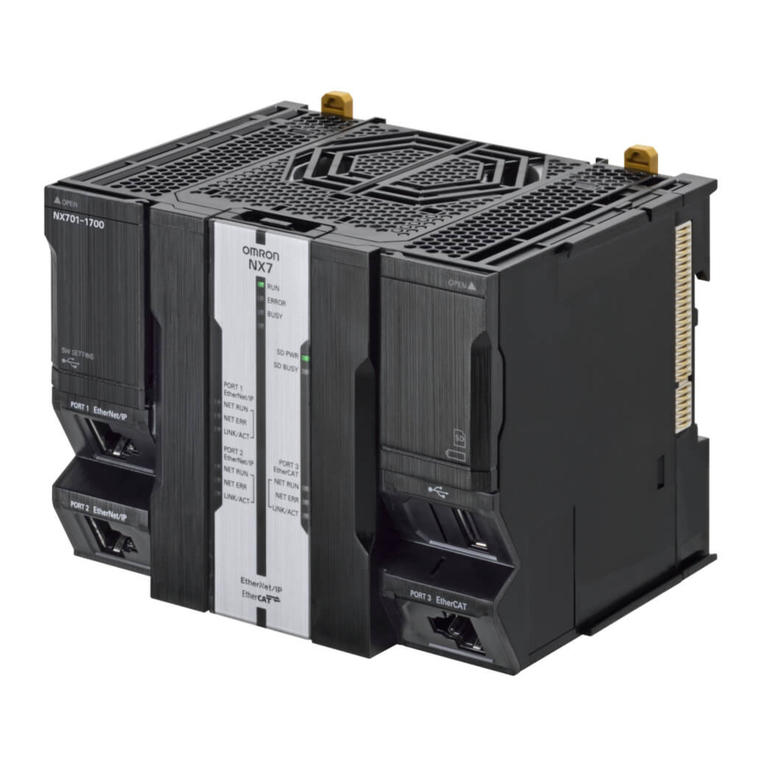
Omron
Omron NX Series user manual
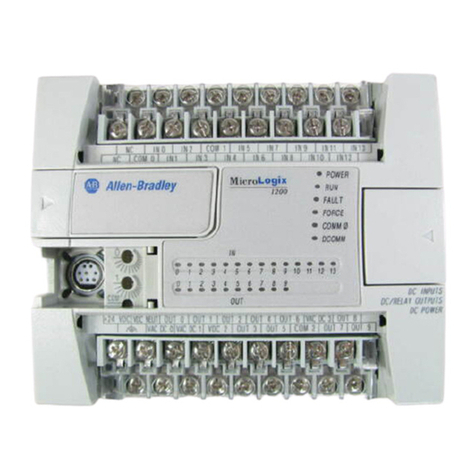
Allen-Bradley
Allen-Bradley MicroLogix 1200 Reference manual

Jandy
Jandy Infinite WaterColors IWCP50W100 Installation and operation manual
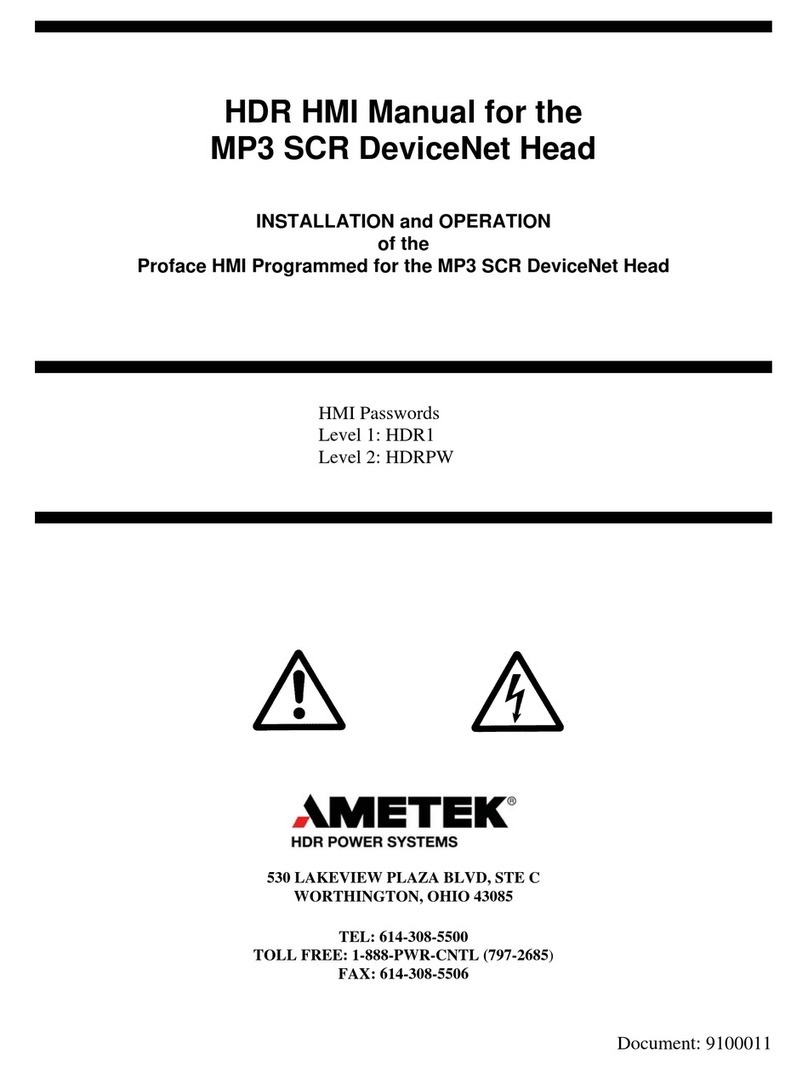
Ametek
Ametek MP3 SCR DeviceNet Head HDR HMI Manual
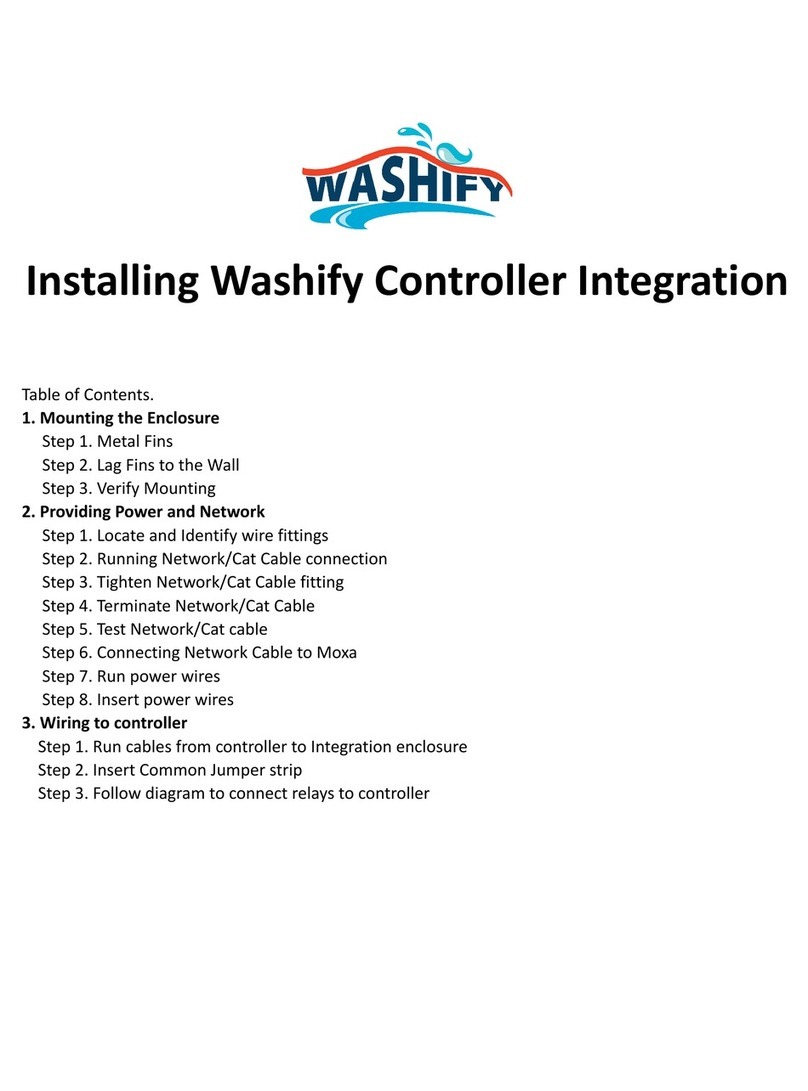
Washify
Washify MOXA Installing
